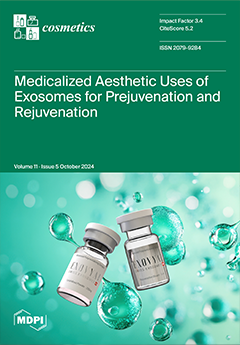A key functionality for cleansing wipes is their efficiency in removing dirt and microbial contamination from the skin to safe or non-detectable levels, traditionally determined using the gravimetric method, which has been reported to be prone to experimental errors. This study evaluates the efficiency of a water-based cleansing wipe, WaterWipes
® (WaterWipes, UC, Drogheda, Ireland), for removing synthetic faecal matter (Feclone
TM, SiliClone Creations LLC, Havertown, PA, United States) and
Escherichia coli (NCTC 10538) from volunteers’ skin, the former using a dermal analytical device called the Antera 3D
TM camera (Miravex Ltd., Dublin, Ireland), and the latter using standard microbiological methods. Feclone
TM was applied to participants’ forearms and the Antera 3D
TM camera captured detailed images of the skin surface before and after wiping. The Antera 3D
TM camera approach was found to be effective in measuring cleaning efficiency, with the wipe removing all detectable traces of the Feclone
TM applied. The total pore area (mm
2), pore count, and total pore volume (mm
3) in test participants post-wiping were observed to be reduced on average by 39.05%, 34.39%, and 39.98%, respectively. The wipe removed 99.99% of
E. coli (NCTC 10538) applied, as measured using the microbial plate count method. In conclusion, the Antera 3D
TM camera method was observed to be effective in evaluating removal of topically applied Feclone
TM.
Full article





